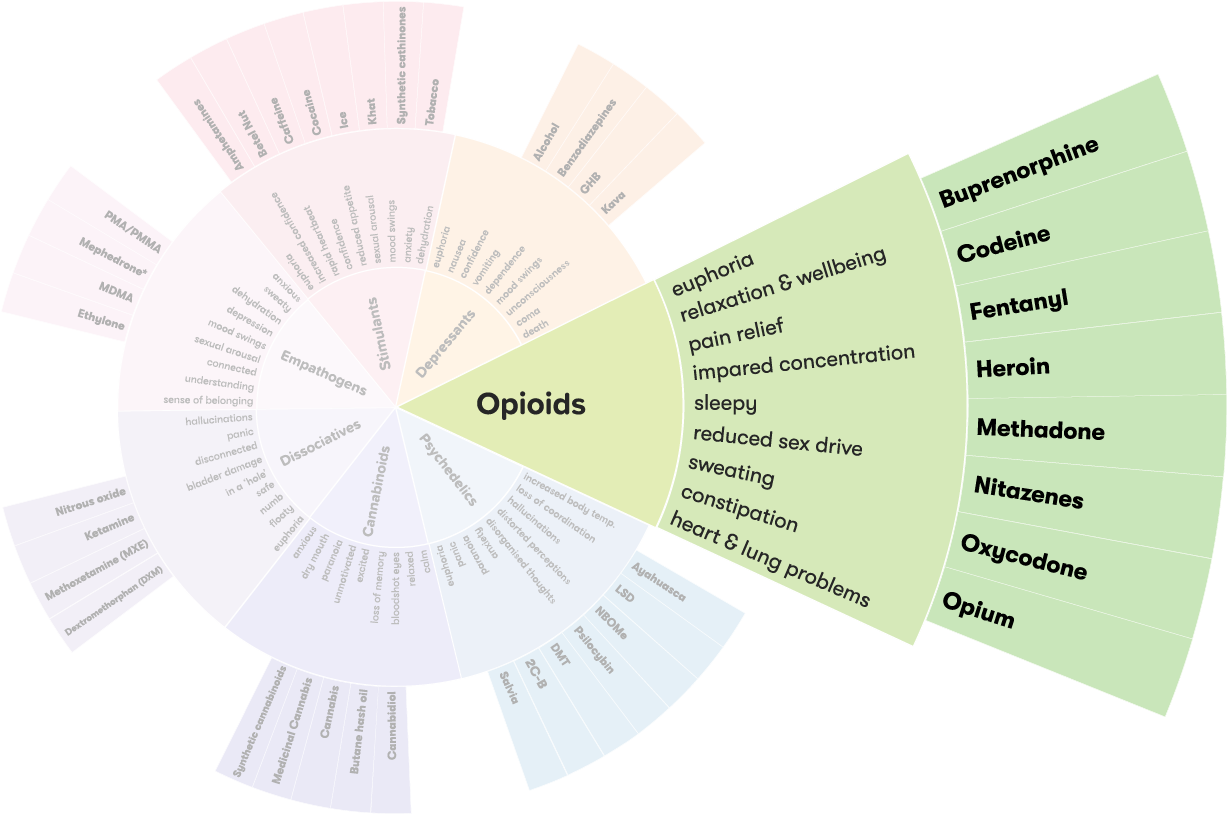How is oxycodone used?
Oxycodone is usually swallowed, but it’s sometimes injected.5
To deter OxyContin® tablets from being injected their formulation was changed in 2014. OxyContin® tablets are now resistant to crushing, and turn into a thick gel when added to water. 6,7 The tablets also have controlled release, meaning they are slower to take effect, even if they are crushed/mixed into a gel.7
Effects of oxycodone
Use of any drug can have risks. It’s important to be careful when taking any type of drug.
Oxycodone affects everyone differently, based on:
- size, weight and health
- whether the person is used to taking it
- whether other drugs are taken around the same time
- the amount taken
- the strength of the drug (varies between specific medicines, and from batch to batch of unregulated drugs)
- the environment (where the drug is taken)
If swallowed, effects may be felt within 10-15 minutes, and last for 3-6 hours for short acting oxycodone forms, or around 12 hours for controlled release oxycodone (e.g. OxyContin®). Effects include:
- pain relief
- dizziness, confusion or difficulty concentrating
- drowsiness
- euphoria or changes in mood
- restlessness
- stiff muscles
- constipation, stomach pain or nausea
- dry mouth
- difficulty urinating
- slow pulse
- excess sweating, flushing and itching
- mild allergic rash or hives.2,8
If you experience side effects or are concerned about your oxycodone use, speak with your doctor.
Impact of mood and environment
Drugs that affect a person’s mental state (psychoactive drugs) can also have varied effects depending on a person’s mood (often called the ‘set’) or the environment they are in (the ‘setting’):
- Set: a person’s state of mind, previous encounters with oxycodone, and expectations of what’s going to happen. For example, feelings of stress or anxiety before using oxycodone may result in an unpleasant experience and make those feelings worse.9
- Setting: the environment in which someone consumes oxycodone – whether it’s known and familiar, who they’re with, if they’re indoors or outdoors, the type of music and light. For example, using oxycodone in a calm, quiet and relaxed environment can lead to, or contribute to, a pleasant experience but being in a noisy, crowded place may result in a negative experience.9
- Being in a good state of mind, with trusted friends and a safe environment before taking oxycodone reduces the risk of having a ‘bad’ trip.
Overdose
If you take a large amount of oxycodone or have a strong batch, you could overdose.
Oxycodone can cause death. Call an ambulance straight away by dialling triple zero (000) if you, or someone else, has any of the following symptoms:
- slow, unusual or difficult breathing
- drowsiness, dizziness or unconsciousness
- slow or weak heartbeat
- nausea or vomiting
- convulsions or fits
- difficulty walking
- facial drooping
- loss of vision
- trouble speaking
- weak muscles2,8
Note: If possible, have the medicine with you so the ambulance officers know what has been taken.
Long-term effects
Regular use of oxycodone may eventually cause:
- increased tolerance and dependence
- reduced bone density and higher risk of fractures
- increased risk of infection
- impacts on hormone levels, leading to reduced sex drive, erectile dysfunction, or menstrual cycle changes.
- sleep problems.2,8,10
Tolerance and dependence
People who regularly use oxycodone can become dependent on the drug. They may feel they need oxycodone to go about their normal activities like working, studying and socialising, or just to get through the day. They may also develop a tolerance to it, which means they need to take larger amounts of oxycodone to get the same effect.2
Mixing oxycodone with other drugs
Mixing oxycodone with alcohol and other drugs – including medications - can have unpredictable effects and increase the risk of harm.
- Oxycodone + alcohol /opioids/benzodiazepines/ GHB/GBL/ ketamine/MXE: high risk of overdose, slow/no breathing, slowed/stopped heart rate, loss of consciousness, and death.
- Oxycodone + ice/cocaine/amphetamine: strain on heart and kidneys, increased risk of overdose.
- Oxycodone + some antidepressants (monoamine oxidase inhibitors – MAOIs): delirium, convulsions, respiratory failure, coma and death.8
More on Polydrug use
Polydrug use is a term for the use of more than one drug or type of drug at the same time or one after another. Polydrug use can involve both illicit drugs and legal substances, such as alcohol and medications.
Reducing Harm
There are ways you can reduce the risk of harm when taking oxycodone: · keep naloxone handy for emergencies and encourage family and friends to learn how to use naloxone. Naloxone can temporarily reverse an opioid overdose.
- Avoid mixing oxycodone with alcohol or other drugs – mixing opioids with depressant drugs increases the risk of overdose.
- Use where you feel safe and with people you trust, and always tell someone what you’ve taken
- Follow the directions given to you by your doctor or pharmacist, or for non-prescribed oxycodone use test a small amount first to reduce overdose risk
- Avoid driving or operating machinery after use
- Always use sterile injecting equipment and never share injecting equipment
- Safely dispose of used injecting equipment.
If injecting drugs there is an increased risk of:
- tetanus
- infection
- vein damage
If sharing needles, there is an increased risk of:
- hepatitis B
- hepatitis C
- HIV and AIDS
Withdrawal
Giving up oxycodone after using it for a long time is challenging because the body has to get used to functioning without it. Withdrawal symptoms may be experienced 6 to 12 hours after taking your last dose, peak around 2 days after stopping, and settle down after around a week.11
Symptoms include:
- hot and cold flushes, sweating and 'goosebumps'
- feeling anxious or irritable
- cravings for oxycodone
- nausea, vomiting, diarrhoea and lack of appetite
- tremors or shaking
- watery eyes, runny nose and sneezing
- trouble sleeping
- increased heart rate
- joint, bone or muscle pain, abdominal (stomach area) pain or headaches.2,11
Getting help
If your use of oxycodone affecting your health, family, relationships, work, school, financial or other life situations, or you’re concerned about a loved one, you can find help and support.
- Call the National Alcohol and Other Drug Hotline on 1800 250 015 for free and confidential advice, information and counselling about alcohol and other drugs
- Help and Support Services search. Find a service in your local area from our list. Simply add your location or postcode and filter by service type to quickly discover help near you.
If you're looking for other information or support options, send us an email at druginfo@adf.org.au
Path2Help
Not sure what you are looking for? Try our intuitive Path2Help tool and be matched with support information and services tailored to you.
Find out more
Oxycodone is a Schedule 8 drug in Australia, meaning it is strictly controlled and requires a prescription.3 Doctors must follow state and territory laws when prescribing oxycodone and must notify, or receive approval from, the appropriate health authority.3
It is illegal to:
- use oxycodone without a prescription
- sell or give an oxycodone prescription to someone else
- forge or alter an oxycodone prescription
- make false claims to obtain oxycodone or an oxycodone prescription from a health professional.
National
In the latest National Drug Strategy Household Survey, 2.2% of the population had used pain-relievers for non-medical purposes in the previous 12 months.4
- Medical JH. What are opioids? n.d. [12.01.2021].
- Healthdirect Australia. Oxycodone 2023 [08.05.2024].
- Department of Health and Aged Care. Therapeutic Goods Act 1989: Therapeutic Goods (Poisons Standard—February 2024) Instrument2024 [08.05.2024].
- Australian Institute of Health and Welfare. National Drug Strategy Household Survey 2022–2023 2024 [29.02.2024].
- Sutherland R, Uporova J, King C, Chandrasena U, Karlsson A, Jones F, et al. Australian Drug Trends 2023: Key Findings from the National Illicit Drug Reporting System (IDRS) Interviews 2023 [08.05.2024].
- Beachler DC, Hall K, Garg R, Banerjee G, Li L, Boulanger L, et al. An Evaluation of the Effect of the OxyContin Reformulation on Unintentional Fatal and Nonfatal Overdose. The Clinical journal of pain [Internet]. 2022; 38(6):[396-404 pp.].
- Therapeutic Goods Administration (TGA). Product Information: OxyContin modified release tablets 2015 [08.05.2024].
- NPS MedicineWise. Consumer medicine information: Endone - Oxycodone hydrochloride 2023 [08.05.2024].
- Nutt D. Drugs without the hot air: making sense of legal and illegal drugs. Cambridge: UIT Cambridge Ltd; 2012 [17.01.2024].
- Kotlińska-Lemieszek A, Żylicz Z. Less Well-Known Consequences of the Long-Term Use of Opioid Analgesics: A Comprehensive Literature Review. Drug design, development and therapy [Internet]. 2022 [18.06.2024]; 16:[251-64 pp.].
- Department of Health and Aged Care. Opioid withdrawal symptoms 2023 [10.05.2024].

